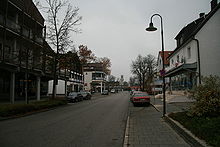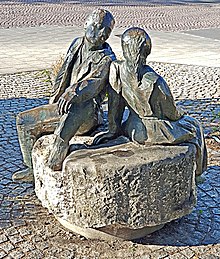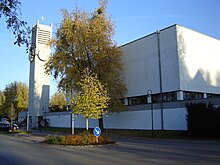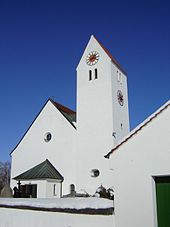Puchheim
| coat of arms | Germany map | |
|---|---|---|

|
Coordinates: 48 ° 9 ' N , 11 ° 21' E |
|
| Basic data | ||
| State : | Bavaria | |
| Administrative region : | Upper Bavaria | |
| County : | Fürstenfeldbruck | |
| Height : | 535 m above sea level NHN | |
| Area : | 12.23 km 2 | |
| Residents: | 21,417 (Dec. 31, 2019) | |
| Population density : | 1751 inhabitants per km 2 | |
| Postal code : | 82178 | |
| Area code : | 089 | |
| License plate : | FFB | |
| Community key : | 09 1 79 145 | |
| City structure: | 2 parts of the community | |
City administration address : |
Poststrasse 2 82178 Puchheim, Germany |
|
| Website : | ||
| Mayor : | Norbert Seidl ( SPD ) | |
| Location of the city of Puchheim in the Fürstenfeldbruck district | ||
Puchheim is a city in the Upper Bavarian district of Fürstenfeldbruck . It is divided into the old, rather rural town center Puchheim Ort and the suburban Puchheim train station, which was only built at the beginning of the 20th century. The municipality was elevated to a city with effect from May 17, 2011.
geography
location
Puchheim is located in the far east of the Fürstenfeldbruck district, about eight kilometers east of Fürstenfeldbruck and 18 kilometers west of central Munich .
Neighboring communities
In the northeast, Puchheim borders directly on Gröbenzell . Both places merge seamlessly. In the east lies the city of Munich, in the south Germering . In the south-west lies the municipality of Alling , in the west Eichenau and in the north Olching .
climate
Puchheim lies in the transition area between the humid Atlantic and the dry continental climate . Other essential weather-determining factors are the Alps as a Central European and the Danube as a regional weather divide . Due to this constellation, the weather is relatively changeable. The hair dryer brings all year round from the south always warm and dry air flows to Puchheim. This is linked to a very good view of the distance, so that the Bavarian Alps can also be seen very clearly.
history
Settlement history
The first traces of settlement go back to Roman times, from which a villa rustica and coin finds around 15 BC. Are occupied. The first documentary mention can be found in Freising church documents between 948 and 957 as Puohheim . In 1494 the sale of a castle stable from Puchheim to the Fürstenfeld monastery is mentioned.
The area of today's Puchheim train station was an agriculturally hardly used fen over the centuries . The Puchheim residents only used this area as a place of refuge in times of crisis. Especially in the war years 1808/09 of the Fifth Coalition War , when French troops sacked the region. It was not until 1840 that the moor was increasingly used for peat cutting. In the 1870s, the surrounding farmers began gaining grassland and cultivating arable land. At the same time, the first permanent branches were established by so-called colonists.
Domestic waste recycling (1898–1949)
In 1869/70 the railway line to Memmingen was built . The first stop for suburban trains was set up in 1896. The expansion of the station, which began in 1899, led to the full appointment for freight traffic and full operation on May 1, 1900. The railway line was the decisive growth factor for the Puchheim Bahnhof district. As early as 1898, Hausmüllverwertung München GmbH was one of the very first industrial companies in the district. Accommodation was also built for some of the 200 or so workers.
Puchheim airfield (1910-1914)
In addition to the household garbage factory, the Puchheim airfield shaped the history of the place at the beginning of the 20th century. As the first airfield in Bavaria, it was built by the Munich association “Academy for Aviation” and opened on May 22, 1910. The association had previously bought 38 hectares of moss meadow land in the area between today's camp, birch and alpine roads for around 60,000 Reichsmarks. According to the press, a total of around 250,000 Reichsmarks was invested, including for a 4 km long concrete wall around the site. The airfield had an area of around one square kilometer and had eight aircraft sheds and a workshop. An 80 m long wooden runway served as a starting aid. In order to be able to cope with the rush of visitors, the Puchheim train station, which was only about one kilometer away, was expanded. According to the authorities, the state railway and the press, up to 50,000 visitors came to the air shows. A restaurant on the airfield calculated for 300 people served to entertain the guests (Franziskaner-Leistbräu; Schottenhamel). According to the latest research, a contemporary indication of the capacity of the inn to be 3,000 guests turned out to be incorrect. The demonstrations by the French aerobatic pilot Adolphe Pégoud , who first showed loops and dives in 1913, were real crowd pullers. With the outbreak of the First World War , the airfield was abandoned and sold by the academy in November 1915. It was not used militarily, although military interests can also be observed here.
POW camp (1914-1920)
The first prisoners of war were interned on the site of the former airfield as early as October 1914. Between 700 and 850 French were billeted in the hangars. The expansion to the regular prisoner of war camp took place very quickly. In the following year, Puchheim was the second largest warehouse in Bavaria after Grafenwöhr . By 1917 a total of 40 barracks and various farm buildings had been built. On August 21, 1917, the camp administration lists 16,141 prisoners from France, Russia, Italy and England. Most of them were posted outside the camp as workers. In the Puchheim area they dug several trenches to drain the moor. The Mühlstetter Graben, which still exists today, was also created in this way. In addition, the prisoners were used as miners at Penzberg , in the construction of an acetone factory for Wacker-Chemie GmbH, and in agriculture. In 1918 Russian prisoners of war were used to dispose of garbage in Munich. At the time of the armistice of 1918, the camp was clearly overcrowded with 24,764 prisoners (including 14,072 Russians and 10,692 French) and a 3800-strong guard. The camp was not closed until 1920 when the last prisoners were repatriated.
A total of 585 prisoners died between 1915 and 1919, around 350 of them alone between November 1918 and February 1919 of the Spanish flu . While French deceased were returned to their homeland after the war, the remains of 321 Russians remained in the so-called Russian cemetery on Lagerstrasse. On October 17, 1917, the Apostolic Nuncio Eugenio Pacelli visited the camp.
Administrative history
Even if a village court is mentioned once in 1442, Puchheim never formed an independent Hofmark . Until 1852 the place was subject to the Starnberg jurisdiction. As part of the administrative reorganization of the newly created Kingdom of Bavaria , Puchheim was added to the Germering tax district in 1808. With its own parish and around 250 inhabitants, the place met the requirements of the second Bavarian municipal edict of 1818 in order to be run as a rural community (extended self-administration rights, community assembly of all citizens with voting rights). On August 1, 1952, some parts of the community of Puchheim Bahnhof were ceded to the newly founded community of Gröbenzell.
Population development
Between 1988 and 2018 the city grew from 18,398 to 21,531 by 3,133 inhabitants or 17%.
politics
City council
The city council of Puchheim consists of 30 council members and the mayor. The municipal council election on March 15, 2020 led to the following result with a turnout of 55.2%:
| Party / list | Share of votes | Seats |
| CSU | 28.8% | 9 |
| Green | 22.5% | 7th |
| SPD | 20.7% | 6th |
| Independent Citizens (ubp) | 14.9% | 4th |
| Free voters | 9.2% | 3 |
| FDP | 3.9% | 1 |
| total | 100% | 30th |
mayor
The first mayor has been Norbert Seidl (SPD) since September 18, 2012 . He received 56.3% of the valid votes. His predecessor was Dr. Herbert Kränzlein (SPD).
After the municipal elections in 2014, Rainer Zöller (CSU) is second mayor and Thomas Salcher (ubp) is third mayor.
Coat of arms and flag
For a long time Puchheim did not have its own coat of arms. It was not until September 11, 1962, that the municipal council decided to adopt one. The approval by the Bavarian State Ministry of the Interior took place on November 6, 1963. The Puchheim coat of arms shows two crossed green beech leaves on a silver background. Underneath is a silver house on a blue background. Both stand for the meaning of the place name "Siedlung bei den Buchen". The colors silver and blue show the affiliation to old Bavaria.
On July 24, 2012, the city council decided to adopt a municipal flag in the stripes blue-white-green with the city coat of arms. Previously, Puchheim had unofficially carried a white and blue striped flag with the municipal coat of arms.
Economy and Infrastructure
Business location
At the Puchheim location there are currently 2289 businesses. With a trade tax revenue of around 13.5 million euros (2006), the municipality in the Fürstenfeldbruck district is one of the economically most important municipalities.
The districts of Fürstenfeldbruck, Dachau, Starnberg and the state capital Munich are managed by the Bavarian Ministry of Economic Affairs and the IHK as a region with a distinctive cluster in the field of laser / optics / photonics. Two out of eight companies ( Scanlab , Alphalaser) with a unique selling point in the region (world-leading companies in the relevant industry) are located in the two Puchheim industrial parks alone. Other companies from these areas are also located on site. The First Sensor AG from Berlin operates a production plant in Puchheim, which is mainly focused on the production of sensors for medical technology.
Every Wednesday and Saturday there has been a weekly market at Am Grünen Markt from 7 a.m. to 12.30 p.m. since 1975 with mostly regional, fresh goods. In addition to the usual everyday products such as bread, cheese, meat and sausage products, fish, eggs, fruit and vegetables, flowers and seasonal items are also offered.
Traffic situation
Until 2010 the B 2 ran directly through Puchheim-Ort. In the meantime, the town center is relieved by the bypass road of the B 2 built in 2010. The B 2 also offers a connection to the A 99 . Puchheim is located on the Bavarian Allgäu Railway and is connected with its S-Bahn station to the S-Bahn network of the Munich S-Bahn and the MVV, the Munich transport and tariff association.
 Train
Train
| line | Line course |
|---|---|
|
|
Geltendorf - Türkenfeld - Grafrath - Schöngeising - Buchenau - Fürstenfeldbruck - Eichenau - Puchheim - Aubing - Leienfelsstraße - Pasing - Laim - Hirschgarten - Donnersbergerbrücke - Hackerbrücke - Hauptbahnhof - Karlsplatz (Stachus) - Marienplatz - Isartor - Rosenheimer Platz - Ostbahnhof - Leuchtenbergring - Berg am Laim - Trudering (- Gronsdorf - Haar - Vaterstetten - Baldham - Zorneding - Eglharting - Kirchseeon - Grafing Bahnhof - Grafing Stadt - Ebersberg) |
 Bus transport
Bus transport
| line | Line course | Operating times | Operating company |
|---|---|---|---|
| X80 | Puchheim (S) South - Lochhausen (S) - Untermenzing (S) - Moosach (S) [U] | Monday to Saturday | MVG |
| 830 | Puchheim (S) North - Gröbenzell - Lochhausen (S) | Every day | Waibel bus |
| 832 | Puchheim (S) North - Puchheim, Obere Lagerstr. - Gröbenzell train station - Graßlfing - ( temporarily: Amperverband -) Olching (S) | Monday to Saturday | Grienstidl |
| X845 | Fürstenfeldbruck (S) - Puchheim Ort - Germering -Unterpfaffenhofen (S) | Every day | Regional traffic Upper Bavaria |
| 853 | Puchheim, Bgm.-Ertl-Str. - Puchheim (S) South - Puchheim Ort - Germering-Unterpfaffenhofen (S) | weekdays on school days | Grienstidl |
| 854 | Puchheim (S) Süd - Gewerbepark Süd - Puchheim Ort, Vogelsangstrasse | Monday to Saturday | Grienstidl |
| 855 | Puchheim (S) North - School Center - Business Park North - Puchheim (S) North (and back) | working days | Grienstidl |
| N80 / N81 night bus | Pasing - Germering - Puchheim Ort - Gröbenzell - Lochhausen - Aubing - Langwied - Pasing ( here : route N80. N81 reversed) | Every day | MVG |
| 8300 | Call taxi from the MVV in the Fürstenfeldbruck district | Every day | Geldhauser |
| 8500 | RufTaxi of the MVV (only from Puchheim town) | Every day | Geldhauser |
education
The Laurenz primary school is located in the municipality of Puchheim Ort. For the district of Puchheim Bahnhof there is the primary school on Gerner Platz, the primary school Puchheim Süd and the secondary school Puchheim. The city of Puchheim is responsible for these schools.
In the same part of the municipality, the Puchheim grammar school (since 1974/75) and the Puchheim secondary school (since 1980) use adjacent parts of the school center designed by the Munich architect Cord Wherse . The Fürstenfeldbruck District Office is responsible for the secondary schools.
Further educational institutions are the Puchheim Music School and the Puchheim Adult Education Center .
Historical buildings and other architecture in Puchheim
A church or church property in Puchheim-Ort was already mentioned in Puchheim's first mentioning document (948 to 957), the steeple of the Maria Himmelfahrt church is of Gothic origin and at least 750 years old. The Catholic parish church of St. Josef (architect Günter Eisele ) was inaugurated in 1966. The Protestant Church of the Resurrection was completed in 1984 under the supervision of the artist Karlheinz Hoffmann .
Across from the Catholic parish church of Sankt Josef is Alois-Harbeck-Platz on an elevated plateau, surrounded by shops, restaurants, social facilities and residential buildings. In its center there is a huge fountain, overgrown with moss and lichen. At the edge of the fountain there is an inscription with the following text: This market complex was built by Anna and Alois Harbeck in 1972 . The owner Laura Stieber, the daughter of the Harbeck family, planned the partial demolition and new construction or the core renovation of the entire ensemble in 2019. At the beginning of 2020, almost all shops and most tenants were given notice. According to the development plan presented in January, only the rear residential complex remains. A full-range supplier with 1200 square meters, a five-story hotel and a seven-story residential complex are to be built.
The Puchheim cultural center , built in 1999, was named one of the most interesting new buildings in Germany by the jury of the Balthasar Neumann Prize in 2000.
One of the few remaining buildings from the early days of the younger district of Puchheim-Bahnhof is the schoolhouse (now a youth center) built in 1929 by the local architect Josef Steindl in a businesslike Heimat style with echoes of the Art Deco movement . From 1946 to 1955 it also served as the first seat of the municipal administration that had moved from the village of Puchheim-Ort to the settlement. After a majority of the municipal council decided at a retreat in autumn 2008 to build a new building complex instead of the house as part of the town center planning, a citizens' initiative was founded. She advocates the sensible continued use of the house, which is important in terms of urban history, architecture and urban development, possibly in a sensitive combination with new extensions. In autumn 2010, an expert report commissioned by the municipality showed the renovation and the possibility of further use. As part of a citizens' workshop in the center of the town, five planning scenarios were then created in April 2011 with the preservation of the historic building, which envisage this either as the head building of an education center (adult education center, library and music school) or a new town hall building. The city council then voted in November 2011 to maintain and renovate as part of the redesign of the city center.
Soil monuments
Town twinning
Puchheim has maintained partnerships with four cities across Europe since 1991. In 2007 the Council of Europe awarded the then municipality with the European diploma for deepening the European idea. In the year of the city survey 2011, Puchheim received the gold-embroidered flag of honor of the Council of Europe for its long-term good relationships with its partner cities. After 1993 a memorial with a plaque with the names of the first three twin cities was erected in front of the town hall . A metal tulip with their embossed city arms protrudes from the stone for each partner municipality.
-
 Nagykanizsa , Hungary (since October 1991)
Nagykanizsa , Hungary (since October 1991) -
 Zalakaros , Hungary (since October 1991)
Zalakaros , Hungary (since October 1991) -
 Attnang , Austria (since May 1993)
Attnang , Austria (since May 1993) -
 Salo , Finland (since 2011)
Salo , Finland (since 2011)
Culture
In addition to the various events organized by the local associations, the municipal administration enriches the local cultural life with a cultural program in the Puchheim Cultural Center (PUC), which opened in 1999 . A broad spectrum is covered by guest performances and in-house productions. Since 2006, the Puchheimer Netzwerk Kultur (an association of local cultural institutions) has been organizing the annual event “Puchheim lives!”, A civic cultural project that is supported by the community. The aim is to provide a common platform for all local cultural workers across generations and milieus.
literature
- Fürstenfeldbruck district office: The Fürstenfeldbruck district - nature, history, culture. Fürstenfeldbruck 1992, ISBN 3-9803189-0-7 .
- Erich Hage (Ed.): Puchheim airfield. Bavaria's first airfield. Volk Verlag, Munich 2010, ISBN 978-3-937200-91-0 .
- Working group culture, customs, history (ed.): Puchheim - The community in old pictures, maps and plans. Geiger-Verlag, Horb am Neckar 1998, ISBN 3-89570-428-8 .
- Community of Puchheim (Ed.): Puchheim. approx. 1983, DNB 890279373
- Achim Puhl (ed.): The old school in Puchheim-Bahnhof. History and stories. Norderstedt 2009, ISBN 978-3-8391-2388-1 .
- Klaus Siegele: Cultural Center. Bürgerhaus Puchheim near Munich = Cultural Center. Civic Center, Puchheim near Munich. In: db Deutsche Bauzeitung. 134, 2000, ISSN 0721-1902 , pp. 64-67.
Web links
- Entry on the coat of arms of Puchheim in the database of the House of Bavarian History
- Puchheim: Official statistics of the LfStat (PDF; 1.66 MB)
Individual evidence
- ↑ "Data 2" sheet, Statistical Report A1200C 202041 Population of the municipalities, districts and administrative districts 1st quarter 2020 (population based on the 2011 census) ( help ).
- ^ Community of Puchheim in the local database of the Bavarian State Library Online . Bavarian State Library, accessed on September 10, 2019.
- ↑ Miscellaneous . In: Oskar Ursinus (Ed.): Flugsport . Illustrated technical magazine and gazette for the entire "aviation industry". No. 11 . Verlag "Flugsport", Frankfurt a. M. May 21, 1909, p. 312 ( online [accessed June 10, 2015]).
- ↑ a b Werner Treibel: History of the German airports . A documentation from 1909 to 1989. Bernard & Graefe, Bonn 1992, ISBN 3-7637-6101-2 , p. 319 .
- ^ Ansbert Vorreiter (ed.): Yearbook on the progress in all areas of aviation 1911 . JF Lehmanns Verlag, Munich 1910, p. 307-308 .
- ↑ Erich Hage: Puchheim airfield. Bavaria's first airfield, Munich 2010, p. 51.
- ↑ Munich waste management company: 120 years of waste management in Munich - from municipal household waste disposal facility to Munich waste management company. (PDF).
- ^ Michael Scherl: The prisoner of war camp in Puchheim in the First World War
- ↑ Dirk Walter: Control visit in the camp
- ^ Wilhelm Volkert (ed.): Handbook of Bavarian offices, communities and courts 1799–1980 . CH Beck'sche Verlagsbuchhandlung, Munich 1983, ISBN 3-406-09669-7 , p. 466 .
- ↑ Merkur.de: Interactive voting map for municipal council elections in Bavaria
- ↑ Süddeutsche Zeitung: Anniversary treat from July 10, 2015.
- ↑ Fürstenfeldbruck District Office, Building the Future - The Fürstenfeldbruck District and its Schools, July 2010 ( Memento of the original from May 6, 2014 in the Internet Archive ) Info: The archive link was automatically inserted and not yet checked. Please check the original and archive link according to the instructions and then remove this notice. (PDF; 6.5 MB).
- ↑ Süddeutsche Zeitung - Peter Bierl: Fear for the Home of July 22, 2019 (accessed on August 7, 2020)
- ↑ Merkur.de - Olf Paschen: Green light for renovation at Harbeck-Platz from January 2, 2020 (accessed on August 7, 2020)
- ↑ Peter Bierl: Puchheim: Dangerous for fire, but worth preserving . In: Süddeutsche Zeitung . March 14, 2011 ( sueddeutsche.de ).
- ↑ puchheim.de ( Memento from April 10, 2011 in the Internet Archive )
- ↑ Webpage of the city of Puchheim: twin cities













